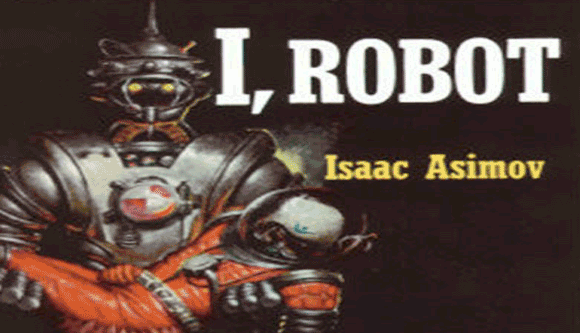A standard Cliche of science fiction is A.I. is a crapshoot. Once mankind creates a artificial life form it will almost invariably turn against it’s creators to take over the world. Though this is not always the case, but for every Lt. Cmndr Data and Wall-E, there is a Hal 9000, Skynet, Matrix, MCP, GLaDOS, Auto, Cylon, or Brainiac. Hell even someone as non threatening as C-3P0 went rouge when he got his head plugged on a battle droid’s body in Attack of the Clones. It gets a little tiresome. Is there anything else that artificial life can do besides try to destroy all humans?
Isaac Asimov, an American scientist wrote many stories exploring the potential Robots could have in society. His novel I, Robot is a collection of short stories which explores the potential effect robots could have on society. This shouldn’t be confused with the 2004 film I, Robot starring Will Smith. Though the film is based off the book, it is more of an action movie than an vision of what the future could hold. In Asimov’s world robots are becoming more and more common place in society for various purposes, from simple household aids, to complex mechanical designers. Powered by positronic brains, robots are capable of thinking faster than human beings, and are able to design more powerful synthetic minds. This sounds like the same set up for the Terminator franchise except every single robot is hard coded with three unbreakable laws.
1. A robot may not injure a human being or, through inaction, allow a human being to come to harm.
2. A robot must obey any orders given to it by human beings, except where such orders would conflict with the First Law.
3. A robot must protect its own existence as long as such protection does not conflict with the First or Second Law.
These three rules are used to safeguard against a robotic revolt. Society excepts robots however there are is a general public fear of a “Frankenstein Complex”. Many of the short stories feature Gregory Powell, Mike Donovan and Dr. Susan Calvin investigating quirks of robotic programing. Each short is a theoretical exploration of robotics issues. How does a mother learn to accept her daughter’s mechanical nanny when, when she doesn’t approve of robots. How does a robot preform it’s duties when it’s reasoning functions have lead it to the conclusion “I think therefore I am?” and therefore nothing else is real? How do robots evolve as we do? One of the more thought provoking stories deals with the concept of a “humanoid”. A “humanoid” is a robot endoskeletion, and positronic brain, with living flesh grafted over it. It is indistinguishable from a human. Instead of going back in time to kill an expectant mother, a man running for Mayor of New York City is accused of being a humanoid by his opposition. It is never revealed if this candidate is a human or a robot but Dr. Calvin comments that robot would be an ideal elected leader. He would be incapable of cruelty, selfishness, incompetence, and would have to do what the electorate told him to do.
The final story “The Inevitable Conflict” is a unique take on the concept of a robot revolt. The machines used to calculate the function of the world’s economy and production, start giving instructions that appear to be flawed or harmful to people. They find that the robots have generalized the first law so instead of not harming a singular human, they now operate to humanity as a whole. The problems people are experiencing are due to robots allowing harm on individuals and small groups in order to protect the species as a whole. As a result the robots have decided the best way to protect humanity is to control it. As a result humanity will prosper but with limited freedom.
Though artificial intelligence is standard trope in sci-fi, too many times robots are relegated to a simple “destroy the world plotline.” I , Robot is a cool vision of the future because it shows a way the world could develop and change, without having to destroy it. It’s hard science fiction and is ultimately thought provoking.

